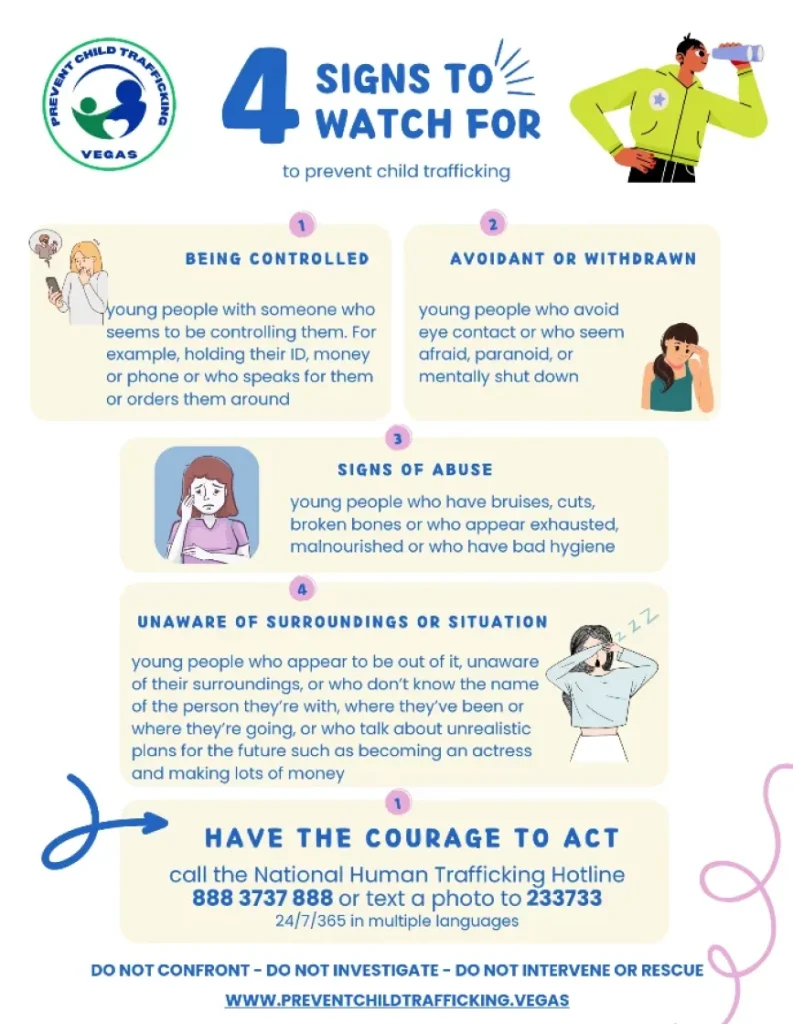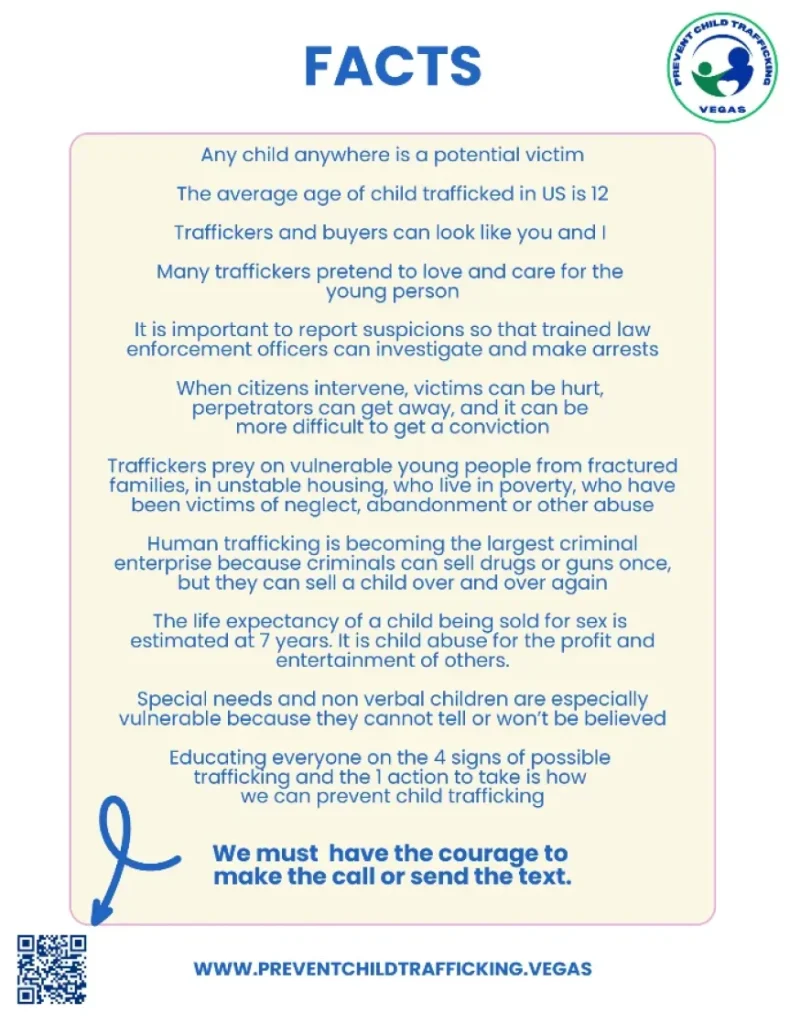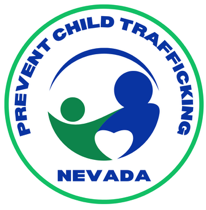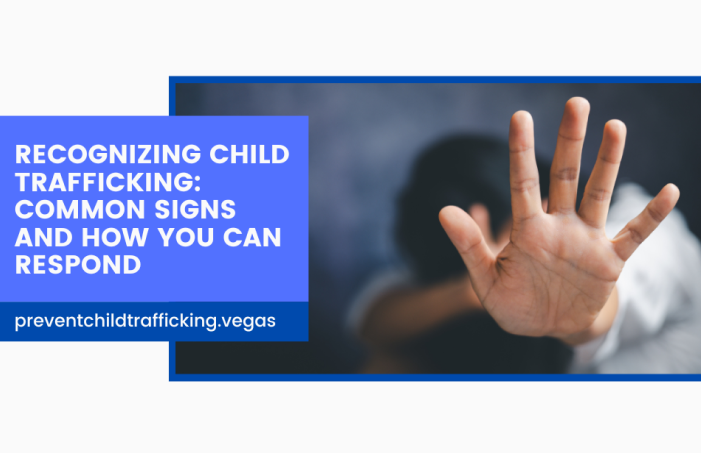Child trafficking is happening here
Child trafficking is a devastating reality that affects children in communities across the United States. It often occurs in plain sight, yet many people don’t recognize the signs or know how to respond. At Prevent Child Trafficking Nevada, we believe community awareness is a powerful tool in the fight against this crime. By understanding the most common signs and knowing how to take action, each of us can play a role in protecting vulnerable children from predators.
What Is Child Trafficking?
Child trafficking involves the recruitment, harboring, or exploitation of children for commercial sex acts or forced labor. Traffickers use manipulation, coercion, deceit and/or fraud to control children, making it extremely difficult for them to escape or ask for help. In many cases, traffickers pose as romantic partners, caregivers, or trusted figures to lure children into dangerous situations.
The Four Most Common Signs of Child Trafficking
Recognizing the signs of child trafficking is the first step toward intervention. Here are the four most common indicators to look out for:
Recognizing Child Trafficking: Common Signs and How You Can Respond
1. Controlled Young People
Trafficked children are often accompanied by someone who appears to control their every move. This person may hold the child’s ID, money, or phone, speak for them, or order them around. The child may seem fearful or hesitant to contradict this person. If you see a young person with someone who seems overly possessive or controlling, it’s a serious red flag.
2.Avoidant or Withdrawn Behavior
Victims of trafficking may avoid eye contact, appear paranoid, or seem mentally shut down. They might display signs of anxiety, fear, or be overly submissive. This withdrawn behavior is often a coping mechanism due to trauma, making it challenging for the child to engage with others.
3. Signs of Physical Abuse or Neglect
Physical signs of abuse, such as bruises, cuts, broken bones, or signs of neglect like malnutrition and poor hygiene, are common among trafficked children. They might appear exhausted, injured, or generally unwell. Traffickers often use drugs and/or physical violence to control victims, or they may fail to provide basic necessities like food, shelter,
and hygiene.
4.Unaware of Surroundings or Situations
Trafficked children might appear disoriented or unsure of where they are, who they’re with, or where they’re going. They may also speak about unrealistic plans for the future, such as becoming a model or an actress and making lots of money—ideas that traffickers often use to
manipulate and control them.
Additional Signs to Watch For
Unexplained Absences from School or Sudden Changes in Behavior
Trafficked children might frequently miss school or show sudden shifts in behavior, such as becoming withdrawn or overly compliant.
Possession of Expensive Items or Unexplained Amounts of Cash
If a child suddenly has new clothes, electronics, or large amounts of cash without a clear explanation, it may indicate that a trafficker is providing these items as part of the grooming process.
Older Romantic Partners or “Friends”
Traffickers often pose as older romantic partners or “friends” who seem to be helping the child out of difficult circumstances. If a child is spending time with someone much older, especially if the relationship is secretive or the older person appears possessive, this is a significant warning sign.
How to Respond If You See the Signs
If you suspect a child is being trafficked, it’s crucial to respond safely and effectively:
1. Do Not Confront the Suspected Trafficker or Victim Directly
Confronting the situation directly could put the child in greater danger and lead to the trafficker moving them to avoid detection. Prioritize the child’s safety and take the steps to allow trained
professionals handle the situation.
2. Contact the National Human Trafficking Hotline
If you believe a child may be a victim of trafficking, call the National Human Trafficking Hotline at 1-888-373-7888 or text 233733 (BeFree). If danger seems imminent, call 9-1-1. The national hotline is staffed 24/7 in multiple languages and ensures confidentiality. Trained responders can take appropriate steps to investigate and intervene safely.
3. Notify Local Law Enforcement
You can also report suspected trafficking to local law enforcement. Provide as many details as possible, such as location, physical descriptions of the child and adults involved, license plate numbers, and any other relevant information.
4.Educate Others in Your Community
Share information about the common signs of trafficking and the toll free hotline and text numbers with your community. The more people are aware, the better chance we have of intervening early and preventing trafficking.
You Can Make a Difference
Preventing child trafficking starts with awareness and action. By learning the most common signs of trafficking and knowing how to respond, you can help protect the most vulnerable members of our community. Together, we can create a safer world for children—one where traffickers have no place to hide.
For more information or to get involved in our efforts to prevent child trafficking, please visit our website at www.preventchildtrafficking.vegas.







